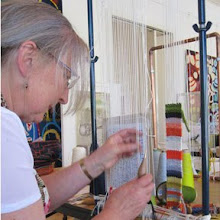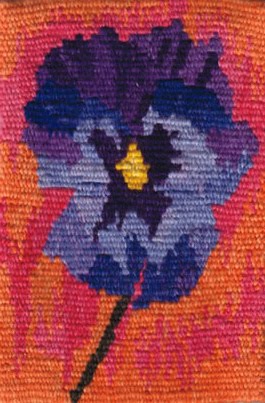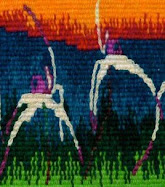I received a copy of Archie Brennan and Susan Martin Maffei's 'Woven Tapestry Techniques' DVD set. 8 DVDs to slowly work my way through. Together that is around 16 hours of instructions and discussion about tapestry weaving. I played them through while I was weaving, just to get a feel for the subject matter in each disc. I then watched each disc with my full attention, taking notes as I watched each one through from start to finish. Sometimes pausing the DVD to make more detailed notes. There is so much information on each disc that I found myself making more extensive notes that I can refer back to later on. As it is difficult to remember exactly what is on each disc that makes an impact on you at the time.
Disc 1
Archie talks briefly about the history of tapestry and looks at different types of looms. He also discusses the different types of warp available for tapestry and points out that certain warp made by different manufactures can be quite different in thickness even though they have the same number of threads. I have experienced this as I bought several cops of seine twine made here in Australia by Downs and Sons from a friend who was no longer weaving tapestry. Although labeled the same, it is quite different from the warp that I now buy from Bockens. Archie shows in detail how to work out the correct warp spacings for different warps. There is an article on the American Tapestry Alliance website written by Archie that addresses this issue here. Archie talks about the different types of tapestry bobbins and demonstrates how to warp a loom. Setting up leashes is also demonstrated and using these can really help to speed up your weaving.
Disc 2
Looks at weaving adjoining shapes. Weaving small rectangles Archie shows how to finish them off so that they are more square on the edges. How to avoid weft ends at the edges of your tapestry. Weaving triangles at different angles and comparing how each method looks. At one point Archie shows a diagram describing the sequence of steps. I think that it is a good idea to pause the DVD, make notes and draw the diagram yourself. It helps to understand it better and you will always have it on hand for future reference.
Disc 3
This disc continues with weaving different angles, looking each time at the difference in the appearance of each example. After the sample is cut from the loom, Archie draws a very detailed diagram going through the techniques used in the sample. The loom is re warped, this time with an endless warp that can be pulled around the loom. Archie draws a detailed diagram of how he intends to weave a curve. Then continuing on with the weaving, discussing what is happening with the stepping. Inking onto the warps is shown and discussed in detail.
Disc 4
Comprises of a slide show of works by Archie and Susan, featuring tapestries from the 1980's to 2000's. Archie and Susan discuss in length the techniques used in each of the tapestries. Often relating back to shape making, especially squares and rectangles, as the making of these shapes is featured in the tutorials. Susan discusses the way that slits feature in her work, sometimes deliberately pulled tighter to suggest a shadow, or the cord on a blind or light fitting. A few of Susan's tapestries feature un woven warps, once to create an effect of mortar in a brick wall, another time to suggest jewelery. There is a very interesting tapestry woven by Susan of a head of a man where she explains how it is woven all the way up on the same warps. In part of the tapestry she has pulled the weft tighter to suggest the shape of the head at eye level, then weaving again with normal tension in the hair. There are many of Archie's life drawing studies in the slide show. It is interesting to see the different approach in each of the tapestries. Especially the way that he had interpreted drawn lines differently into tapestry and how fabric has been translated in different ways.
Disc 5
Looks at eccentric weaving. A small shape inked onto the warps is firstly woven by stepping up the warps then filling in the shape. A second shape is drawn onto the warps, and then woven in eccentric weaving that features so strongly in medieval tapestries. Archie explains that the maximum angle for this kind of weaving would be no more than 30 degrees. Any higher angle would cause distortion in the weaving and risk buckling in a tapestry. A demonstration is then given, weaving back around the shape using traditional stepping. Archie inks a circle onto the warps and then takes you through the steps of weaving. A circle is woven on both an even and an odd number of warps and the two are then compared.
Disc 6
Addresses the problem of weaving slits. The need to sew them if a tapestry is to hang on it's side, as it stresses the structure of the tapestry. Different types of dovetailing or weft interlock is demonstrated. Along with traditional sewing techniques that includes how to sew when weaving around a single warp. There is an article showing diagrams of sewing slits on Archie and Susan's website here. Different ways of hatching is demonstrated, showing how to graduate from light to dark. Susan shows a drawn diagram of how to do double half hitches along with four different ways to begin and end weft threads. A diagram shows different methods of beginning and ending wefts in a tapestry without beginning at the edges. Susan then goes on to explain a diagram 'stealing a pass' Once again it is a good time to pause the DVD and draw the diagrams yourself. There is so much information on each of the discs that it is really difficult to remember what exactly is on each one.
Disc 7
Hatching and half passing is continued in detail. Archie discusses the sample that he has woven. Included is 'pick and pick' and the weaving of dots to suggest shading, which features beautifully in some of Archie's life drawing studies. Weaving slits to create shadow and creating fine lines is demonstrated. As is 'taking your line for a walk' A weavers mark is discussed and demonstrated. A drawn summary of the sample is then explained. Discussion about the all important issue of hanging your finished tapestry is covered and Susan takes you through ways of mounting your work. An area that a lot of us struggle with, especially in small format tapestries.
Disc 8
Susan demonstrates how to warp up for 'Four Selvedge' weaving. Showing some examples and then comparing them to tapestries woven in the traditional way. A slide show of Archie's tapestry series 'The Earth Awaits Dersu Usala' Archie talks at length about the inspiration behind these tapestries. Susan discusses detailed areas in her tapestries that address the use of half passes and hatching. Followed by a slide show of more of both Archie and Susan's tapestries. With a final farewell at the end, commenting that though between them they have at the time of filming, 71 years of tapestry experience between them and 'were not finished yet'
In 2000 I had the opportunity to do a workshop at South West Institute of Tafe in Warrnambool with Archie and Susan. It was the first time that I had ever left Coen, then only three years old. I had not done very much weaving since suffering from tendinitis in 1995, so I was pretty rusty! My friend Kerry Martin who began the tapestry diploma the same year as me, was having her Graduate Exhibition and participating in the workshop.
I still have my notes and sample from the workshop. On opening my notebook today to refresh my memory of the class. I found this quote from Archie scribbled in large letters inside the front cover.
' Never forget....tapestry is a cloth...first and last'

I struggled with the class for a while, learning a new language of weaving. I took a photo of a diagram that Susan had drawn on the blackboard to describe 'high' and 'low' turns. I can still distinctly remember while engrossed in the task of 'taking my line for a walk' Archie who was sitting on a stool surveying the class, started laughing, and pointing in my direction saying 'I saw it!' me? saw what?
'I saw the penny drop! you got it!'
I know that doing the class did have a huge impact on my weaving from that time on. Little words in my head came to mind, while my fingers were doing their work. As mentioned in the DVD, it will become a language that you don't think about, you just do it. And for that I will be forever grateful.
The drawings in my book are by Archie, showing me how some of his more difficult tapestries were woven. In the back of the book I found a list of quotes that I had written down during the workshop so I will share some of them here, they are still as relevant today.
'Constant tension change WILL BE a problem to you for the rest of your life'
'Think of weft as a snake, looping its way over and under the warps'
'To make a line, the weft is like the tires on a car, the outside must travel further around the curve'
From the perspective of someone who learned tapestry via a correspondence course. With only two weeks each year of an opportunity for hands on instruction. I really wish that these DVDs had been available when I began my journey into tapestry. There is so much information on the discs and I have only skimmed over some of it. The advantage of being able to pause the discs and write notes. To slowly work your way through weaving a sample at your own pace, which is not often the case in many workshops. The initial outlay for the DVD set would no where equal the cost of attending a class, with travel expenses and accommodation costs to consider as well. I can highly recommended purchasing the DVD set, regardless of if you are an experienced weaver or new to tapestry.
The DVDs and accompanying booklet can be purchased via Archie and Susan's website here or via Garry Benson in Australia garrybenson@ozemail.com.au
It would pay to check you region first, as to which format you need PAL or NTSC?







Wow Debbie this is a thorough discussion of the Brennan/ Maffei DVD set. I have had mine for a few months and learned so many things. My approach was just as yours, review, then spend time with each individual tape taking notes and absorbing the information. I still review them from time to time to find things I hadn't really noticed before.
ReplyDeleteThanks for sharing your detailed review!
Hi Janette, there is a lot of info there to take in. I really think that the only way to digest it all is to write it down. You are welcome to use my notes. Debbie.
ReplyDeleteThank you for this thorough review of these DVDs. I've been thinking about getting them for a while--maybe it's finally time!
ReplyDeleteHi Sherri, I am certain that they will be a great investment!
ReplyDeleteThanks for all that info Deb. I will have to investigate getting them. I did a face-to-face course but, unless you weave frequently and diligently, a lot of it goes straight out of your head. It sounds great to have the various topics available for refreshing the memory.
ReplyDeleteGreat and thoughtful review. Just what i need to purchase them. Thank you so much! kaz
ReplyDelete